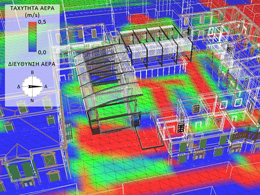STUDENTS PROJECTS
PROJECTS2013

27 March, 2015
Student residences in the old Nicosia
Courtyard as a bioclimatic element.
Students: Irene Kyritsi
Supervisor: Katherine Liapi
Department of Architecture, University of Patras
Presentation date: October 2014
This thesis examines the procedure of courtyard designing aiming to the optimal natural ventilation in the context of bioclimatic architecture. The analysis is achieved by using the parametric program of Autodesk Vasari which supports CFD feature (Computational Fluid Dynamics) that simulates the movement of the air.
Courtyard is an architectural element that is very often found in the traditional architecture of Nicosia. Correctly designed, a courtyard can contribute significantly to the thermal comfort of a building.
For the purpose of this study a block with nine abandoned preserved buildings in the old Nicosia has been selected for the creation of Halls of Residence for the University of Cyprus. This area has been selected due to several reasons. To begin with, the historical centre of the Cyprus capital has a great architectural, cultural and educational value. At the same time, the Department of Architecture of the University of Cyprus is at this area. Moreover, this area lies near two places of access to the walled Nicosia: the Paphos gate and the Solomos square. It is also located in a short distance from the commercial axes of Lydras and Onasagorou while the Solomos square is the starting point of the city buses.

In the west side of the block there is a mansion - probably constructed in the early 20th century -, two other dwellings built in the Ottoman period and a corner building probably constructed in the mid-20th century. In the south side there are three buildings which are alike and probably took their final form during the early 20th century. In the east side there is the only one floor building of the block which was probably completed during the late 19th - early 20th century. In this side there is another building which was modified in the mid-20th century. Through this research the courtyards of the buildings are merged to a central single courtyard around which the existing buildings are found. Afterwards, by applying small modifications to the buildings and adding new volumes a unified building derives.

The location, the height, the width and the geometry of the new volumes added is based on the results of the air simulations. The air circulation in the courtyard is achieved by the use of two barriers: the first barrier is located at the same side from which the air enters the building and the second barrier is located at the opposite side. This way, the air moves above the lower barrier which is located at the side from which the air enters and then it's directed above the courtyard. Then it's directed insight the courtyard due to the higher barrier.
This thesis suggests the division of the existing courtyard into two smaller ones. When the two courtyards communicate through a confined space the air speed increases. The courtyard located at the north side of the initial courtyard is smaller while the courtyard located at the south side - in order to benefit from the sunlight - is bigger and is also the main circulation and living space.
In terms of the wind, it can be wanted or unwanted depending on its direction. For example, the north wind in the area is frequent during the winter thus it should be blocked so that the thermal comfort of the courtyard will be preserved. During the summer, the frequent entrance of the south wind improves ventilation. In this case, the greater the air speed is the better the thermal comfort conditions in the courtyard are. The west wind is frequent throughout the year and even more frequent during the summer. Its access in the courtyard is important especially during the summer since it cools the construction and the courtyard area.

Based on the analysis of the air movement our study suggests the addition of the following constructions in the block:
- A volume which will divide the initial courtyard into a north and a south courtyard and will have such geometry that will drive away the north wind and drive in the south wind.
- A volume in the eastern side of the courtyard which will bridge the height difference between the west and the east side.
- Horizontal and vertical louvers that will enhance the desired air movement in the courtyard and will also serve as shading devices.
- A moving structure (panels) which will control the air passage between the courtyards. The structure must be closed during the winter and kept open during the rest of the year.

This thesis suggests a building program which will serve the needs of a student residence in the specific area. The program includes:
- Basement (parking space)
- Ground floor (reception/information center, canteen, game room, travel agency, bookstore, multipurpose hall, fitness center, language center)
- 1st floor (study room, student clubs hall, shared kitchen and dining room, laundry room, apartments)
- 2nd floor (apartments)
The surrounding buildings hold the facilities while the intermediate semi-opened spaces are used for circulation purposes. There are several sitting areas in the courtyard as well as a pond to increase humidity and suitable planting to improve the shading conditions.














